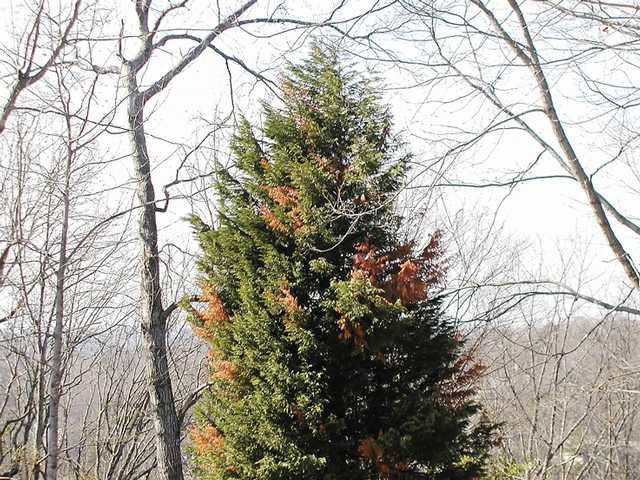Question: The tips of several branches on my Leyland cypress have turned brown. Is this insect damage or some kind of disease, and how should I treat it?Answer: There are two diseases of Leyland cypress that cause branches to turn brown and die on otherwise healthy-looking trees. The most common of these is bot canker, caused by the fungus Botryosphaeria dothidea (you can see why they just call it bot canker).
If you examine the bark at the base of the brown twigs, you should see sunken or flattened canker that has or is oozing sap. B. dothidea may produce long narrow cankers on the trunk that are a foot long or more.
The bot fungus will most likely attack sites that have been physically damaged by handling or by branches rubbing together. Trees stressed by severe drought, such as we are having now, are quite vulnerable.
Seiridium canker, caused by the fungus Seirdium unicorne, is the other fungal disease that sometimes attacks Leyland cypress. The symptoms are similar to that of bot canker, but S. unicorne is not as common.
Fungal diseases can often be managed by pruning the infected stems several inches below the diseased area. Protect plants from injury, avoid planting them too close together so as to promote good air circulation, and water them if you can.
Fungicides are not effective once the disease takes hold, but may help prevent infection on small trees that have been physically damaged or stressed.
Q: What is artillery fungus?A: Artillery fungus (also called shotgun fungus and cannonball fungus) is a rather unique fungus that is just recently becoming known in the landscape trade.
More precisely, it is developing a rather notorious reputation for making annoying stains on buildings, automobiles, fences, etc.
This annoying fungus (Sphaerobolus stellatus) may colonize manure or other organic material such as wood mulch. It would probably never be noticed, except for the mechanism it has come up with to disperse its reproductive spores.
As the fungi grow, they develop dark brown spores sitting on top of specialized cup-shaped cells that gradually accumulate liquid. When enough pressure builds up in the cells they burst forth like a miniature mortar firing a shell.
The result, which doesn’t become apparent until the damage is done, is a spattering of tiny yellow-brown to black spots on nearby surfaces (up to 18 feet away). These disk-shaped spots may be one to two millimeters in diameter (about a sixteenth of an inch) and may not be noticed except on a light-colored surface.
The artillery fungus is quite sensitive to light and tends to "aim" at light-colored surfaces that are nearby. Due to a very sticky substance (nature’s own super glue) covering the spores, they are difficult to remove from their "targets."
This is not a major problem in the landscape, and hopefully it will never become one. It is something the homeowner should be aware of when considering what type of mulch to use and where to use it.
Mulching with bark or pine straw instead of wood chips will lessen the chances of an artillery unit locating there. Adding a fresh layer of new mulch to cover the old mulch each year should also help avoid a problem.
If mulch is composted before being applied to the landscape it will encourage growth of beneficial organisms that may prevent the artillery fungus from forming.
Russ England is a Master Gardener trained and certified in horticulture and related areas through by the Georgia Cooperative Extension.

